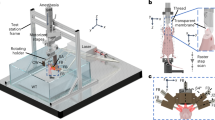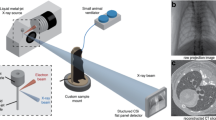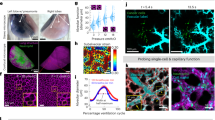Abstract
Stable, high-resolution intravital imaging of the lung has become possible through the utilization of vacuum-stabilized imaging windows. However, this technique is extremely invasive and limited to only hours in duration. Here we describe a minimally invasive, permanently implantable window for high-resolution intravital imaging of the murine lung that allows the mouse to survive surgery, recover from anesthesia, and breathe independently. Compared to vacuum-stabilized windows, this window produces the same high-quality images without vacuum-induced artifacts; it is also less invasive, which allows imaging of the same lung tissue over a period of weeks. We further adapt the technique of microcartography for reliable relocalization of the same cells longitudinally. Using commonly employed experimental, as well as more clinically relevant, spontaneous metastasis models, we visualize all stages of metastatic seeding, including: tumor cell arrival; extravasation; growth and progression to micrometastases; as well as tumor microenvironment of metastasis function, the hallmark of hematogenous dissemination of tumor cells.
This is a preview of subscription content, access via your institution
Access options
Access Nature and 54 other Nature Portfolio journals
Get Nature+, our best-value online-access subscription
$29.99 / 30 days
cancel any time
Subscribe to this journal
Receive 12 print issues and online access
$259.00 per year
only $21.58 per issue
Buy this article
- Purchase on Springer Link
- Instant access to full article PDF
Prices may be subject to local taxes which are calculated during checkout






Similar content being viewed by others
References
Looney, M.R. et al. Stabilized imaging of immune surveillance in the mouse lung. Nat. Methods 8, 91–96 (2011).
Entenberg, D. et al. In vivo subcellular resolution optical imaging in the lung reveals early metastatic proliferation and motility. Intravital 4, 1–11 (2015).
Martin, E.A. Concise Medical Dictionary (Oxford University Press, 2010).
Vinegoni, C., Lee, S., Feruglio, P.F. & Weissleder, R. Advanced motion compensation methods for intravital optical microscopy. IEEE J. Sel. Top. Quantum Electron. 20, 115–121 (2014).
Presson, R.G. Jr. et al. Two-photon imaging within the murine thorax without respiratory and cardiac motion artifact. Am. J. Pathol. 179, 75–82 (2011).
Dunphy, M.P., Entenberg, D., Toledo-Crow, R. & Larson, S.M. In vivo microcartography and subcellular imaging of tumor angiogenesis: a novel platform for translational angiogenesis research. Microvasc. Res. 78, 51–56 (2009).
Harney, A.S. et al. Real-time imaging reveals local, transient vascular permeability, and tumor cell intravasation stimulated by TIE2hi macrophage-derived VEGFA. Cancer Discov. 5, 932–943 (2015).
Karagiannis, G.S. et al. Neoadjuvant chemotherapy induces breast cancer metastasis through a TMEM-mediated mechanism. Sci. Transl. Med. 9, eaan0026 (2017).
te Velde, E.A. et al. Impaired healing of cutaneous wounds and colonic anastomoses in mice lacking thrombin-activatable fibrinolysis inhibitor. J. Thromb. Haemost. 1, 2087–2096 (2003).
Ritsma, L. et al. Intravital microscopy through an abdominal imaging window reveals a pre-micrometastasis stage during liver metastasis. Sci. Transl. Med. 4, 158ra145 (2012).
Ohsawa, K., Imai, Y., Kanazawa, H., Sasaki, Y. & Kohsaka, S. Involvement of Iba1 in membrane ruffling and phagocytosis of macrophages/microglia. J. Cell Sci. 113, 3073–3084 (2000).
Kumar, V., Abbas, A.K. & Aster, J.C. Robbins Basic Pathology E-Book (Elsevier Health Sciences, 2017).
Baker, R. & Nissim, J. Expressions for combining standard errors of two groups and for sequential standard error. Nature 198, 1020 (1963).
Hanna, G. et al. Automated measurement of blood flow velocity and direction and hemoglobin oxygen saturation in the rat lung using intravital microscopy. Am. J. Physiol. Lung Cell. Mol. Physiol. 304, L86–L91 (2013).
Fiole, D. & Tournier, J.N. Intravital microscopy of the lung: minimizing invasiveness. J. Biophotonics 9, 868–878 (2016).
Entenberg, D. et al. Setup and use of a two-laser multiphoton microscope for multichannel intravital fluorescence imaging. Nat. Protoc. 6, 1500–1520 (2011).
Entenberg, D. et al. In Current Protocols in Cell Biology (Eds. Bonifacino, J.S. et al.) Chapter 19 (John Wiley & Sons, Inc., 2013).
De Alva, W.E. & Rainer, W.G. A method of high speed in vivo pulmonary microcinematography under physiologic conditions. Angiology 14, 160–164 (1963).
Fingar, V.H., Taber, S.W. & Wieman, T.J. A new model for the study of pulmonary microcirculation: determination of pulmonary edema in rats. J. Surg. Res. 57, 385–393 (1994).
Kimura, H. et al. Real-time imaging of single cancer-cell dynamics of lung metastasis. J. Cell. Biochem. 109, 58–64 (2010).
Ritsma, L., Vrisekoop, N. & van Rheenen, J. In vivo imaging and histochemistry are combined in the cryosection labelling and intravital microscopy technique. Nat. Commun. 4, 2366 (2013).
Travis, W.D. Classification of lung cancer. Semin. Roentgenol. 46, 178–186 (2011).
Scholten, E.T. & Kreel, L. Distribution of lung metastases in the axial plane. A combined radiological-pathological study. Radiol. Clin. (Basel) 46, 248–265 (1977).
Braman, S.S. & Whitcomb, M.E. Endobronchial metastasis. Arch. Intern. Med. 135, 543–547 (1975).
Herold, C.J., Bankier, A.A. & Fleischmann, D. Lung metastases. Eur. Radiol. 6, 596–606 (1996).
Bernal, P.J. et al. Nitric-oxide-mediated zinc release contributes to hypoxic regulation of pulmonary vascular tone. Circ. Res. 102, 1575–1583 (2008).
Miyao, N. et al. Various adhesion molecules impair microvascular leukocyte kinetics in ventilator-induced lung injury. Am. J. Physiol. Lung Cell. Mol. Physiol. 290, L1059–L1068 (2006).
Rodriguez-Tirado, C. et al. Long-term high-resolution intravital microscopy in the lung with a vacuum stabilized imaging window. J. Vis. Exp. http://dx.doi.org/10.3791/54603 (2016).
Fidler, I.J. The relationship of embolic homogeneity, number, size and viability to the incidence of experimental metastasis. Eur. J. Cancer 9, 223–227 (1973).
Liotta, L.A., Saidel, M.G. & Kleinerman, J. The significance of hematogenous tumor cell clumps in the metastatic process. Cancer Res. 36, 889–894 (1976).
Aceto, N. et al. Circulating tumor cell clusters are oligoclonal precursors of breast cancer metastasis. Cell 158, 1110–1122 (2014).
Entenberg, D. et al. A protocol for the implantation of a permanent window for high-resolution imaging of the murine lung. Protocol Exchange http://dx.doi.org/10.1038/protex.2017.134 (2017).
Ovchinnikov, D.A. et al. Expression of Gal4-dependent transgenes in cells of the mononuclear phagocyte system labeled with enhanced cyan fluorescent protein using Csf1r-Gal4VP16/UAS-ECFP double-transgenic mice. J. Leukoc. Biol. 83, 430–433 (2008).
DuPage, M., Dooley, A.L. & Jacks, T. Conditional mouse lung cancer models using adenoviral or lentiviral delivery of Cre recombinase. Nat. Protoc. 4, 1064–1072 (2009).
Choi, J.A. & Lim, I.K. TIS21/BTG2 inhibits invadopodia formation by downregulating reactive oxygen species level in MDA-MB-231 cells. J. Cancer Res. Clin. Oncol. 139, 1657–1665 (2013).
Kearns, M.T. et al. Fas ligand-expressing lymphocytes enhance alveolar macrophage apoptosis in the resolution of acute pulmonary inflammation. Am. J. Physiol. Lung Cell. Mol. Physiol. 307, L62–L70 (2014).
Wagner, W.W. Jr. & Filley, G.F. Microscopic observation of the lung in vivo. Vasc. Dis. 2, 229–241 (1965).
Schneider, C.A., Rasband, W.S. & Eliceiri, K.W. NIH Image to ImageJ: 25 years of image analysis. Nat. Methods 9, 671–675 (2012).
Harney, A.S., Wang, Y., Condeelis, J.S. & Entenberg, D. Extended time-lapse intravital imaging of real-time multicellular dynamics in the tumor microenvironment. J. Vis. Exp. 112, e54042 (2016).
Thévenaz, P., Ruttimann, U.E. & Unser, M. A pyramid approach to subpixel registration based on intensity. IEEE Trans. Image Process. 7, 27–41 (1998).
Acknowledgements
This technology was developed in the Gruss-Lipper Biophotonics Center and the Integrated Imaging Program at Albert Einstein College of Medicine. We acknowledge the support of these Centers in this work: Einstein's Integrated Imaging Program, Montefiore's Ruth L. Kirschstein T32 Training Grant of Surgeons for the Study of the Tumor Microenvironment (CA200561), NIH grants CA100324, CA216248, P30CA013330, and SIG #1S10OD019961-01. We thank M. Rottenkolber, R. Ibagon and A. Leggiadro of the Einstein Machine Shop for their skilled craftsmanship and design insight; and we thank C. Rodriguez-Tirado, B. Canella and U. Steidl's lab for help with evaluating blood counts.
Author information
Authors and Affiliations
Contributions
D.E. and J.C. conceived of the technique; J.C. conceived of the biological goals for performance; D.E. designed the window and stage plate; D.E., S.V. and F.B. developed the surgical protocol; S.V., D.E., G.S.K., M.O. and J.C. designed the validation experiments; D.E. and S.V. performed the imaging; S.V. and L.B. performed the validation experiments; Y.W. bred the mice; P.G. performed 3D reconstructions; D.E., L.B. and P.G. performed the blood-flow measurements; S.V., D.E., G.S.K., M.O. and J.J. evaluated the validation results; D.E. and G.S.K. performed statistical analyses; M.O. and J.J. evaluated HE, IBA1 IHC and TMEM IHC in fixed lung sections; and D.E., S.V. and J.C. wrote the paper.
Corresponding authors
Ethics declarations
Competing interests
D.E., S.V., and J.C. have submitted a provisional patent application on the window (US provisional patent application no. 62/548,455).
Integrated supplementary information
Supplementary Figure 1 Quantification of macrophages in lung tissue under the window.
A) IBA1 staining in the lung under the window shows no statistical difference (p>0.29) in macrophage number over the two weeks of window implantation. Control is from a mouse without a window. B) Example low magnification (left) and high magnification (right) images of IBA1 staining in lungs from mice without windows (top, Control) and mice bearing windows post-operative day 4 (bottom, POD 4). Number of dots indicate the number of mice for each day. Error bars = s.e.m. Significance determined by one-way ANOVA comparing each POD to control with Dunnett correction for multiple comparisons.
Supplementary Figure 2 Imaging capabilities of WHRIL.
Stills from a time-lapse video showing circulating monocytes (yellow arrow heads) and resident macrophages (yellow arrows). B) The high spatial stability allows the use of blood averaging. Unlabeled circulating erythrocytes and leukocytes cause temporary occlusions of the intravascular fluorescent dextran leading to an inability to distinguish the vascular boundaries. Blood averaging smoothes these occlusions and clearly defines the vascular boundary.
Supplementary Figure 3 Image of tumor cells trapped in the lung vasculature where the endothelia are transgenically labeled with the fluorescent protein tdTomato.
x = luminal side of endothelia, * = abluminal side of endothelia. Transgenic mouse = B6.FVB-Tg(Cdh5-cre)7Mlia/J x B6.Cg-Gt(ROSA)26Sortm14(CAG-tdTomato)Hze. Red = td-Tomato Ve-Cad labeled endothelial cells, Green = GFP labeled E0771 tumor cells.
Supplementary Figure 4 Quantification of blood flow rate.
Quantification of blood flow rates can be accomplished by imaging the passage of 2.5 μm fluorescent microspheres injected retro-orbitally through the lung vasculature. Some spheres become trapped in the vasculature (cyan arrows), presumably by macrophages, while others flow through with the circulation. Use of a microscope with an EMCCD detector enables continuous acquisition of photons during the exposure time. This results in visualization of the entire microsphere track as a blurred streak through the image (yellow arrows). Measurement of the length of the tracks, divided by the acquisition time of the frame, allows quantification of the cell speeds which is presented as a histogram. 144 tracks in n=2 mice were analyzed. Error = s.e.m.
Supplementary Figure 5 Visualization of tumor cell extravasation in the lung.
A) Stills of data, without the application of blood averaging, corresponding to Figure 4B showing extravasation of tumor cells. B) 3-dimensional reconstructions of imaging data shown in Figure 4B. C) Stills of data, without the application of blood averaging, corresponding to Figure 4C showing extravasation of a tumor cell. Green = GFP tumor cells, Cyan = CFP macrophages, Red = Ve-Cad labeled endothelia and 155kD TMR dextran.
Supplementary Figure 6 Relocalization using microcartography enables identification of tumor cell fate between imaging sessions.
A&B) Left: Image of a tumor cell trapped in the vasculature on POD 1. Right: Image of the same field of view relocated using microcartography 24 hours later. A) The tumor cell (white dotted outline) can be seen to have left the field of view either by recirculation or apoptosis. B) The tumor cell can be seen to have crossed the endothelium into the extravascular space (yellow dotted outline). Red = td-Tomato Ve-Cad labeled endothelial cells and TMR labeled dextran, Green = GFP labeled E0771 tumor cells, Blue = SHG.
Supplementary Figure 7 The SHG signal from the collagen I network can be used to verify that microcartography accurately returns to the same region of interest day after day in both the spontaneous and the experimental metastasis models.
Similar patterns in the network (colored arrows in each day) can be identified in day despite slight morphological changes like straightening of the fibers. A) Experimental metastasis model. Extraction of just SHG channel taken from the same field of view shown in Figure 5B. Z-projection of 8 slices taken 3 μm apart. B) Spontaneous metastasis model. Extraction of just the SHG channel taken from the same field of view shown in Figure 5C. Z-projection of 2 slices taken 3 μm apart.
Supplementary Figure 8 Growth curve of primary mammary tumors correlate strongly with the number of disseminated tumor cells observed on the left lung (measured as number of disseminated tumor cells per mm2 of lung).
n=8 mice, line=linear regression with slope ± s.e.m., R2 = goodness of fit).
Supplementary information
Supplementary Text and Figures
Supplementary Figures 1–8 (PDF 2114 kb)
Life Sciences Reporting Summary
Life Sciences Reporting Summary (PDF 160 kb)
Supplementary Protocol
A Protocol for the Implantation of a Permanent Window for High-Resolution Imaging of the Murine Lung (PDF 658 kb)
Supplementary Data 1
Microcartography software setup file. (ZIP 159363 kb)
Supplementary Data 2
Raw data for supplementary figures. (XLSX 10 kb)
The WHRIL is well tolerated.
WHRIL bearing mice are able to perform tasks of daily living (grooming, feeding, nesting, stretching, etc.) without impediment. (MOV 6163 kb)
Time-lapse video of healthy lung vasculature shown in Supplemental Figure 1.
Left: raw, unprocessed video showing single cell resolution imaging. Right: Same video with red (blood) channel averaged over time to improve definition of the vascular boundaries. Time between frames = 1 sec, FOV = 170 μm. Cyan = CFP labeled myeloid cells, Red = vasculature labeled by 155kD TMR-dextran. (AVI 48388 kb)
Time lapse video of raw data shown in Figure 4A showing arrival of a tumor cell to join other cells trapped in the lung vasculature.
Time between frames = 1.35 min. Time stamp = hh:mm:ss. FOV = 117x67 μm. Green = tumor cell, red = vasculature, cyan = macrophages. (AVI 159005 kb)
Time lapse video of blood averaged data shown in Figure 4B showing extravasation of an experimentally metastasized tumor cell from inside the lung vasculature into an alveolus.
Left: Maximum intensity projection of 3 slices (9 μm) within the lung vasculature. Right: 3D reconstruction of the entire data set (8 slices, 24 μm) FOV = 60 μm. Time between frames = 64 sec. Time stamp = hh:mm:ss. (AVI 314502 kb)
Visualization of tumor cell extravasation in an experimental metastasis model.
Raw unprocessed data corresponding to Figure 4B showing a single optical section of the lung vasculature. Time between frames = 64 sec. Green = GFP tumor cells, Cyan = CFP macrophages, Red = Ve-Cad labeled endothelia and 155kD TMR dextran. Time stamp = hh:mm:ss. (AVI 157254 kb)
Video of data presented in Figure 5A showing one cell of a group of spontaneously metastasized tumor cells appearing to undergo division in the lung.
Time between frames = 1.42 min. FOV = 75 μm. Green = GFP labeled tumor cells, Red = 155kD TMR dextran, Blue = SHG from collagen I fibers. Time stamp =mm:ss (AVI 41476 kb)
41592_2018_BFnmeth4511_MOESM12_ESM.avi
Two frames from Supplemental Figure 3B showing co-registration of vasculature and an extravasated tumor cell. (AVI 17284 kb)
Video of functional TMEM in the lung showing transient vasculature leakage (permeability).
Yellow arrow indicates location of transient vascular leakage seen as red dextran appearing in the extravascular space. (AVI 39748 kb)
Rights and permissions
About this article
Cite this article
Entenberg, D., Voiculescu, S., Guo, P. et al. A permanent window for the murine lung enables high-resolution imaging of cancer metastasis. Nat Methods 15, 73–80 (2018). https://doi.org/10.1038/nmeth.4511
Received:
Accepted:
Published:
Issue Date:
DOI: https://doi.org/10.1038/nmeth.4511
This article is cited by
-
Intravital imaging to study cancer progression and metastasis
Nature Reviews Cancer (2023)
-
Real-time imaging of dynamic tissues
Nature Methods (2023)
-
Crystal ribcage: a platform for probing real-time lung function at cellular resolution
Nature Methods (2023)
-
Investigating the Influence of Heterogeneity Within Cell Types on Microvessel Network Transport
Cellular and Molecular Bioengineering (2023)
-
NAD(P)H fluorescence lifetime imaging of live intestinal nematodes reveals metabolic crosstalk between parasite and host
Scientific Reports (2022)



